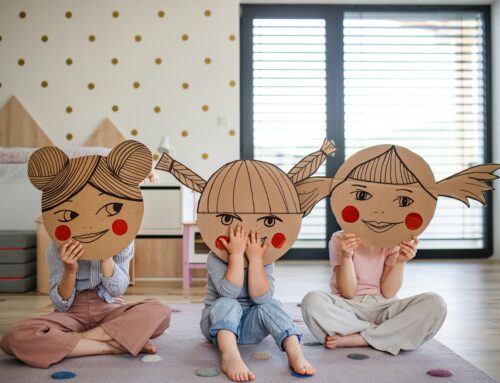Are you worried about your child’s worrying? Have you noticed a change in your child? Maybe they’ve become more worried, clingy, or distant. Anxiety in children can show up in many ways and negatively impact your child’s experience at school, at home, with friends, or with extracurricular activities.
 Maybe there are certain topics they don’t want to talk about, or they look fearful when you ask about a specific teacher or friend. Or they’re afraid to talk to their teacher about their questions or to make up a test from when they were sick or something else important, which harms their grade. Carlsbad Christian Counseling can assist in creating strategies for healthy communication with your child, helping to foster emotional growth and resilience.
Maybe there are certain topics they don’t want to talk about, or they look fearful when you ask about a specific teacher or friend. Or they’re afraid to talk to their teacher about their questions or to make up a test from when they were sick or something else important, which harms their grade. Carlsbad Christian Counseling can assist in creating strategies for healthy communication with your child, helping to foster emotional growth and resilience.
Feeling anxious is a normal human emotion. Students typically feel anxious before a test, a presentation, a big game, or a performance. Feeling anxious usually brings with it some physical symptoms such as nausea, rapid heart rate, or “butterflies” in the stomach.
Taking slow deep breaths, focusing on being present (what you can see, hear, touch, smell, and taste), and imagining a positive outcome, can help refocus everyday anxious feelings to propel us toward resiliency and accomplishment.
However, there’s a difference between normal feelings of anxiety or worry and those that negatively affect our day-to-day lives. Sometimes anxiety can look like a child being stubborn or distracted. Here are some typical ways anxiety might show up in kids, though this is by no means an exhaustive or clinical list of criteria:
- Constantly bringing up the same subject or seeming to have thoughts that are stuck in a loop, no matter how much you reassure them.
- Refusal to do certain activities (including going to school) and often has a hard time explaining why.
- Trouble concentrating in school because they’re so focused on their fears and concerns.
 Struggling to maintain their grades, but where a learning disability or other mental health diagnoses have been ruled out.
Struggling to maintain their grades, but where a learning disability or other mental health diagnoses have been ruled out.- Refusal to engage with friends.
- Endlessly scrolling on a phone or tablet.
- Avoiding certain foods/activities/places/people.
- Seeming more withdrawn and quieter than usual.
- Self-isolation.
- Looking fearful and acting clingy when anxious.
- Trouble sleeping.
- Has become more defiant or aggressive.
- Appearing to obsess over doing everything perfectly.
- Expressing aches and pains that could be physical signs of anxiety and stress, such as tight muscles, headache, back pain, stomach problems, and heart racing where the doctor has ruled out a physical cause.
How anxiety impacts your child’s education.
Any parent who has had a child with anxiety knows the struggle it is to get the child to school. Indeed, EdWeek recently did a survey of high school students with 16% naming “anxiety” as a reason for not attending school. Another 7% said they didn’t attend school because they were worried about their physical safety at school.
The article began, “Aside from physical illness and bad weather, anxiety is the top reason high school students missed school in the past year, according to the results of a student survey from the EdWeek Research Center.”
In January 2023, in the San Diego Unified School District, 28.5% of all students were considered “chronically absent,” meaning they had missed 10% of instruction the prior month.
Unfortunately, when students miss school, they get behind in instruction making it harder – and more anxiety-provoking – to get back to school, because students will have missed so much instruction. That only exacerbates that feeling of being overwhelmed and increases the anxiety.
Types of anxiety in children.
 In 2019, before the pandemic increased anxiety to its current levels, the Centers for Disease and Control Prevention said 9.4% of all kids ages 3-17 had a diagnosed anxiety. A CDC article on Children’s Mental Health specifies:
In 2019, before the pandemic increased anxiety to its current levels, the Centers for Disease and Control Prevention said 9.4% of all kids ages 3-17 had a diagnosed anxiety. A CDC article on Children’s Mental Health specifies:
“When there are so many fears and worries that they interfere with school, home, or play activities, the child may be diagnosed with an anxiety disorder. Examples of different types of anxiety disorders include:
- Being very afraid when away from parents (separation anxiety).
- Having extreme fear about a specific thing or situation, such as dogs, insects, or going to the doctor (phobias).
- Being very afraid of school and other places where there are people (social anxiety).
- Being very worried about the future and bad things happening (general anxiety).
- Having repeated episodes of sudden, unexpected, intense fear that come with symptoms like heart pounding, having trouble breathing, or feeling dizzy, shaky, or sweaty (panic disorder).
“Anxiety may present as fear or worry, but can also make children irritable and angry. Anxiety symptoms can also include trouble sleeping, as well as physical symptoms like fatigue, headaches, or stomachaches. Some anxious children keep their worries to themselves and, thus, the symptoms can be missed.”
Tips for parents.
If you are concerned that your child is struggling with anxiety, here are some tips that can help:
- Allow your child an opportunity to express their feelings. While some of their fears might not make sense to you, as an adult, imagine how that might feel if you were your child. Empathizing with your child’s emotions can be more beneficial than dismissing their fears as irrational. Those big emotions are scary, so remind them that you are there with them.
- Parents can help co-regulate their child’s big emotions, by sitting with them in their big feelings. Taking slow, deep breaths with them, hugging them, or just letting them know you’re there with them can help them feel safe and move from emotionally dysregulated to regulated.
- Practice deep breathing. There are a lot of deep breathing techniques, but, in general, breathe in with your nose, hold it, and let it fill your whole body like a balloon, then slowly breathe out with your mouth.
- Talk about a favorite peaceful place – it can be real or imagined. Help them create a safe, peaceful place in their mind that they can imagine when their anxiety is starting to creep up. It can be helpful to encourage them to create artwork to remind them of their peaceful place.
- Help your child discover some grounding activities that help them feel less anxious, like coloring, dancing, listening to music, playing with Legos, etc.
- Sit with your child and notice what’s in front of you using the five senses: Name all the things you can see, hear, touch, smell, and taste.
- Read a children’s book about anxiety to help normalize their experience. Here are two options: God, I Feel Scared: Bringing Big Emotions to a Bigger God by Michelle Nietert and Tama Fortner; Captain Snout and the Super Power Questions: How to Calm Anxiety and Conquer Automatic Negative Thoughts (ANTs) by Dr. Daniel Amen and Brendan Kearney
- Good nutrition, hydration, sleep, and exercise are also important ways to combat anxiety.
When to get help for anxiety in children.
 All children will experience the emotions of worry and anxiety at times in their lives. However, when those emotions become overwhelming and start negatively impacting their daily life and functioning, that’s when it’s important to see a mental health professional.
All children will experience the emotions of worry and anxiety at times in their lives. However, when those emotions become overwhelming and start negatively impacting their daily life and functioning, that’s when it’s important to see a mental health professional.
Often your school counselor or pediatrician can offer a referral. You can also search through the list of therapists here at California Christian Counseling to find a therapist experienced in working with children and teens.
Typically, a therapist will offer both a safe space for your child to share their thoughts and feelings, as well as evidence-based coping skills to use when anxiety starts creeping in. Child Psychologists and Licensed Marriage and Family Therapists are required to have experience and training in working with children and teens. Finding a warm and creative therapist can offer the help you and your child need to reduce anxiety’s negative impact on their life. Contact a counselor at Carlsbad Christian Counseling for comprehensive support.
Even when working with a mental health professional, it is often helpful to consult with your pediatrician to rule out any physical concerns and to assess for possible medication support. Additionally, including your child’s teacher(s) and school counselor in the treatment plan can provide the support your child might need while at school.
Resources:
inewsource.org/2023/01/25/san-diego-unified-students-are-missing-school-at-alarming-rates/
www.edweek.org/leadership/students-are-missing-school-because-theyre-too-anxious-to-show-up/2023/10
www.amazon.com/God-Feel-Scared-Bringing-Emotions/dp/0310140897
www.amazon.com/Captain-Snout-Super-Power-Questions/dp/0310758327/ref=sr_1_1?qid=1704684702&refinements=p_27%3ADr.+Daniel+Amen&s=books&sr=1-1
Photos:
“Sadness”, Courtesy of mprietou, Pixabay.com, CC0 License; “Tantrum”, Courtesy of Keira Burton, Pexels.com, CC0 License; “Desperation”, Courtesy of Getty Images, Unsplash.com, Unsplash+ License; “School”, Courtesy of Caleb Oquendo, Pexels.com, CC0 License
-
Cyndie Claypool De Neve: Author
As a Christian Licensed Marriage and Family Therapist (LMFT) in California, I love being used by God to bring healing and hope to those who are hurting. I enjoy working with school-aged children, teens, college students, families, couples, and adult...
Recent Posts
-
Kate Motaung: Curator
Kate Motaung is the Senior Writer, Editor, and Content Manager for a multi-state company. She is the author of several books including Letters to Grief, 101 Prayers for Comfort in Difficult Times, and A Place to Land: A Story of Longing and Belonging...
DISCLAIMER: THIS ARTICLE DOES NOT PROVIDE MEDICAL ADVICE
Articles are intended for informational purposes only and do not constitute medical advice; the content is not intended to be a substitute for professional medical advice, diagnosis, or treatment. All opinions expressed by authors and quoted sources are their own and do not necessarily reflect the opinions of the editors, publishers or editorial boards of Stone Oak Christian Counseling. This website does not recommend or endorse any specific tests, physicians, products, procedures, opinions, or other information that may be mentioned on the Site. Reliance on any information provided by this website is solely at your own risk.









